Forced Orthodontic Eruption (FOE) before Dental Implantation
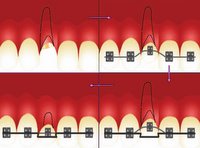 The treatment of esthetic areas with dental implants represents a new challenge for the clinician. Placementof a single-unit implant is indicated for fractured or periodontally compromised teeth. In 1993, a modification ofthe forced eruption technique, called “orthodontic extrusive remodelling,” was proposed as a way to augment both soft- and hard-tissue profiles at potential implant sites. This case report describes augmentation of the coronal softand hard tissues around the teeth with severe periodontal destruction , which was achieved by forced orthodontic extrusion before implant placement. This technique may be used to improve primary anchorage of a dental implant, fill the alveolar socket with bone, preserve interdental bone height and increase the amount of attached gingiva.
The treatment of esthetic areas with dental implants represents a new challenge for the clinician. Placementof a single-unit implant is indicated for fractured or periodontally compromised teeth. In 1993, a modification ofthe forced eruption technique, called “orthodontic extrusive remodelling,” was proposed as a way to augment both soft- and hard-tissue profiles at potential implant sites. This case report describes augmentation of the coronal softand hard tissues around the teeth with severe periodontal destruction , which was achieved by forced orthodontic extrusion before implant placement. This technique may be used to improve primary anchorage of a dental implant, fill the alveolar socket with bone, preserve interdental bone height and increase the amount of attached gingiva.An approach to soft- and hard-tissue augmentation is forced orthodontic eruption (FOE). As first described by Heithersay and Ingber, this technique is based on osteophysiologic and orthodontic principles. It has been usedf requently because of its demonstrated advantages, including correction of isolated infrabony defects, repositioning ofthe gingival margin and clinical lengthening of thecrown.
Clinical Case Report by Perio: (FOE by Dr. Tsai)
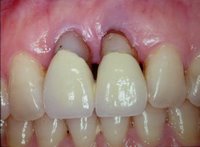

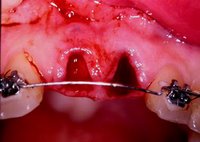
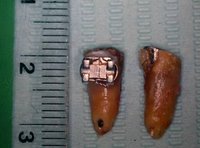

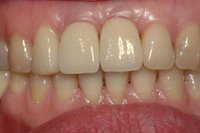

@Buccal and coronal bone augmentation using forced eruption and buccal root torque( Int J Periodontics Restorative Dent. 2003 Dec;23(6):585-91.)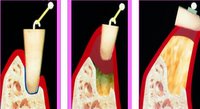
*Multidisciplinary Treatment Approach for Enhancement of Implant Esthetics(Dr. Wang 2004)




2 Comments:
Int J Periodontics Restorative Dent. 1993 Aug;13(4):312-33.
The role of orthodontic extrusive remodeling in the enhancement of soft and hard tissue profiles prior to implant placement: a systematic approach to the management of extraction site defects.
Salama H, Salama M.
University of Pennsylvania School of Dental Medicine, Philadelphia 19104.
A classification scheme that systematizes the wide range of regenerative potential of common extraction site topographies is presented. Within this system, the parameters for immediate implant placement and preliminary ridge augmentation are discussed. In addition, a new adjunctive role for orthodontic extrusion is introduced. This approach is intended to manipulate "hopeless" teeth to modify their local defect environments, thereby enhancing the predictability of subsequent implant placement at those sites.
Application of bone remodeling theories in the simulation of orthodontic tooth movements.
Bourauel C, Vollmer D, Jager A.
Department of Orthodontics, University of Bonn, Germany. bourauel@uni-bonn.de
A numerical model that calculates bone apposition and resorption around a tooth root on the basis of bone remodeling theories was developed to simulate orthodontic tooth movements. The model was used to calculate different kinds of orthodontic tooth movements, that were then compared with the expected movements based on clinical experience. For simulation of the movements the root of a canine was modeled in an idealized way in the form of an elliptical paraboloid and was processed with a finite element program. The finite element model was loaded with defined force systems. Two model assumptions were used to calculate the bone remodeling process. The mechanical loads firstly in the periodontal ligament and secondly in the alveolar bone were taken to simulate the following tooth movements: 1. mesial tipping around the center of resistance (force system at the bracket: isolated torque MY = 5 Nmm), 2. rotation around the long axis of the tooth (MZ = 5 Nmm), 3. uncontrolled tipping around the root tip (FX = 1 N, MZ = 5 Nmm), 4. canine retraction (FX = 1 N, MY = -9.5 Nmm, MZ = 5 Nmm), 5. and 6. extrusion/intrusion (FZ = +/- 0.5 N, MX = +/- 2.5 Nmm). Comparison with clinical experience was performed by calculating the orthodontic tooth movements based on the assumption of a fixed position of the center of resistance. It could be demonstrated that the numerical model of orthodontic bone remodeling can be used to calculate orthodontic tooth movements. However, the results are strongly dependent on the model assumptions. The model simulating the bone remodeling on the basis of the loading of the periodontal ligament delivers results that are in very good accordance with the biomechanical assumptions of the position of the center of resistance. However, marked side effects occurred with the second model, especially in the simulations of uncontrolled tipping, translation and intrusion/extrusion. Clinically, these side effects cannot be observed.
Post a Comment
<< Home